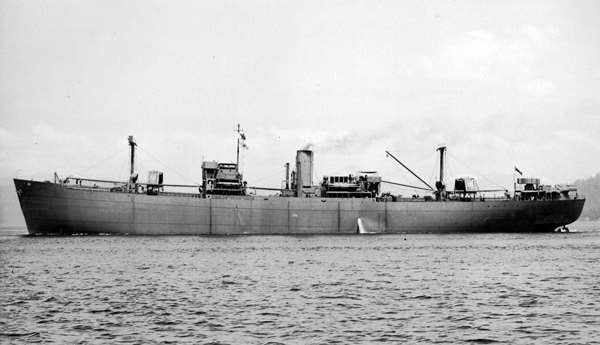Fort Chilcotin
British Steam merchant

Photo from City of Vancouver Archives, CVA 195-2
| Name | Fort Chilcotin | ||
| Type: | Steam merchant (North Sands) | ||
| Tonnage | 7,133 tons | ||
| Completed | 1942 - West Coast Shipbuilders Ltd, Vancouver | ||
| Owner | H. Hogarth & Sons Ltd, Glasgow | ||
| Homeport | London | ||
| Date of attack | 24 Jul 1943 | Nationality: | |
| Fate | Sunk by U-172 (Carl Emmermann) | ||
| Position | 15° 03'S, 32° 35'W - Grid FR 1517 | ||
| Complement | 57 (4 dead and 53 survivors). | ||
| Convoy | JT-2 (detached) | ||
| Route | Rio de Janeiro (19 Jul) - Freetown - Glasgow | ||
| Cargo | 9103 tons of rock crystal and iron ore | ||
| History | Completed in June 1942 for US War Shipping Administration (WSA), lend-leased on bareboat charter to British Ministry of War Transport (MoWT). | ||
| Notes on event | At 20.59 hours on 24 July 1943 the unescorted Fort Chilcotin (Master John Kerr), detached from convoy JT-2 two days earlier, was hit on the port side in the engine room by one of two G7e torpedoes from U-172 while steaming on a non-evasive course at 8.5 knots about 370 miles east-southeast of Bahia. The explosion stopped the engines immediately and killed four crew members on watch below. No distress signals could be sent as the aerials were carried away by debris. The surviving crew members and eleven gunners (the ship was armed with one 4in, one 12pdr, four 20mm and two machine guns) abandoned ship within 10 minutes when the ship quickly settled by the stern, but she then remained afloat because the engine room bulkheads held. The port aft lifeboat had been destroyed and the two forward boats were lowered too quickly and swamped, so the majority of the survivors abandoned ship in the starboard aft boat, which was also the motor boat and contained the emergency wireless set. Others jumped overboard and swam to four rafts that were cut adrift, while the master and about six men remained in the swamped port lifeboat. At 22.03 hours, the U-boat missed with a coup de grâce but a second fired six minutes later struck the Fort Chilcotin aft and caused her to sink immediately with her bow and stern rising out of the water due to a broken back. U-172 surfaced shortly afterwards and approached the motor boat, asking for a man to come aboard for questioning. The boatswain volunteered and told the Germans that the master and chief officer went down with the ship. He was asked where the ship was bound and if he had heard about the sinking of African Star, Harmonic and other ships, but gave only vague answers. After about 15 minutes, the boatswain was allowed to return to the lifeboat before the U-boat left and he later described the commander as very civil, who expressed his regret at having had to sink his ship and also wanted to hear his opinion regarding the outcome of war. The survivors recovered the stores from the rafts and righted the two smaller boats, but with 38 men in the motor boat and 15 in one of the smaller boats they found that the other boat was not required and left it behind when setting sail in fine and clear weather at a speed of about 3 knots. They had plenty of food and water and sent distress signals from the emergency set each morning but received no replies. At 09.30 hours on 29 July, they were picked up by the Argentine steam tanker Tacito after attracting her by firing red flares when her lights were spotted at daybreak. The tanker also hoisted both lifeboats aboard and took them to Rio de Janeiro, arriving on the morning of 1 August. | ||
| On board | We have details of 7 people who were on board. | ||
If you can help us with any additional information on this vessel then please contact us.
